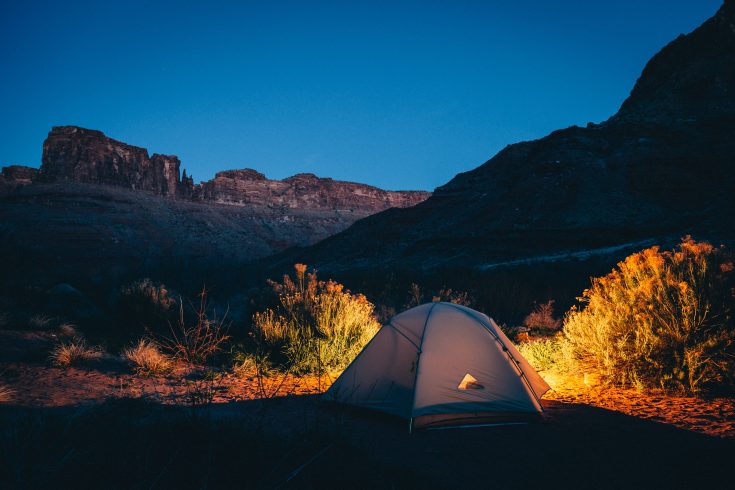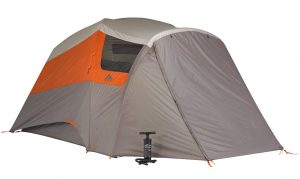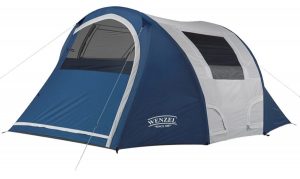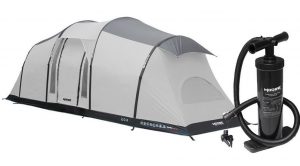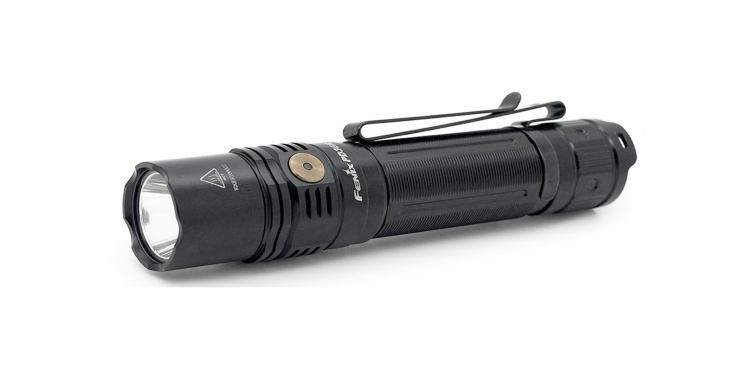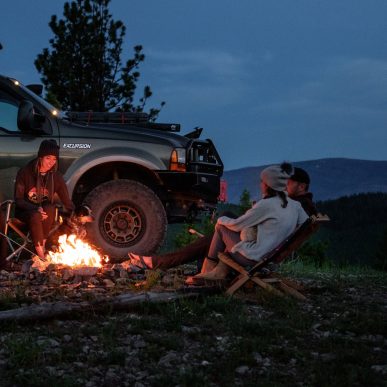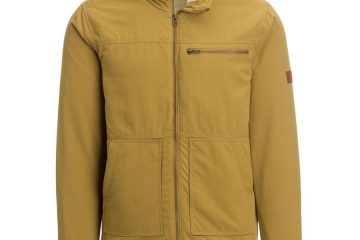Air tents, also known as inflatable tents, aren’t exactly knew, but are becoming more and more popular and even better as time goes on. Instead of relying on the traditional pole design – whether aluminum or fiberglass – an inflatable tent will feature a tube structure that becomes rigid once inflated. While this may not seem very stable, inflatable tents have actually come quite far in terms of durability and rigidity, and you can find some inflatable tents cut out for the most-extreme of mountain conditions.
Contents
Choosing An Inflatable Air Tent
Why choose an air tent in the first place? Their lack of poles, which makes them easier to pack up and carry around, also makes them very easy to setup, especially for one person. All you have to do is stake down the corners and pump it up; you could blow it up manually, if you wanted, but most tents come with small, light pumps, while others use inflatable sacks to push air in quickly (the same way most packrafts are inflated). Pump it up and you’re ready to go. Easy.
You will also probably notice that most inflatable tents on the market are quite large – capable of sleeping 6-10 people. This is because the quick, easy setup of an inflatable tent makes putting together large tents, which are usually difficult and time-consuming, much, much simpler. No more messing a dozen or more poles. Just pump up and go.
Durability And Weatherability
And while the tubes always have the risk of being punctured or torn, this happens much less than you might expect. They are generally quite well reinforced and are less fragile than a pole that might snap easily, and actually hold up quite well to adverse weather conditions, such as high winds; their inflatable poles may not be as rigid as poles, but again, this keeps them from snapping in extremely high winds. You will always want to carry a repair kit with you to patch up any leaks that might spring up; it’s like patching up a bike tube. But they do hold up quite well.
Are They Lighter Than Regular Tents?
This will obviously depend on the model. Some inflatable tents will be lighter than heavy pole tents, though you won’t find any ultralight models (under 2 pounds). The thickness required for durable fabric kind of outweighs that, so while inflatable tents have their pluses, they aren’t the best for long-distance, ultralight backpacking. The HemiPlanet Cave weighs 10 pounds, for example.
Below you’ll find our picks for the Best Inflatable Air Tents of 2018.
Best Inflatable Air Tents Of 2018

For Backpacking: Nemo Morpho Elite 2P
With room for 2 and weighing only about 5.2 pounds on the trail, the Nemo Morpho Elite might be the best optional you have for a lightweight air tent for backpacking. Not quite as light as you could get from a regular tent, but on the lighter end of inflatable tents. The walls are made from non-breathable silnylon, while the upper is made with super breathable waterproof OSMO™ fabric that lets condensation escape rather quickly. The “poles” are Nemo’s AirSupported Technology, which are made of 2 layers – an outer layer that provides rigidity, strength, and puncture resistance, and a thin replaceable inner tube containing the air.
With 39 square feet of floor space, it’s quite spacious and in fact, could even fit a third person if you don’t mind being a bit snug. It packs down to 7”x14”, inflates quickly and painlessly, and holds up to all 3-season use.
HemiPlanet Fistral
While not as light as the Nemo Morpho Elite, the Fistral is another lightweight inflatable tent for backpacking. Coming in at 5.5 pounds, it fits 2 people with 45 square feet of floor space but is still small enough to justify bringing for 1-person.
Hemiplanet uses a unique geodesic design, which gives the tent extra stability and resistance to high winds, while also looking pretty cool. The airframe is made from entirely recycled material, the outside is stiff polyester, while the inner tube is thermo-plastic PU. There are two doors, two vestibules, and two vents that can be opened or close to let moisture escape.
One thing Hemiplanet tents are not, is cheap. But they are exceptionally well-built and engineered, and this is a heavy-duty tent that will hold up to any 3-season use while setting up in seconds. One thing to note, however, is that no pump is included.
Vango Odyssey 800
If you can’t tell, this tent is huge. Created by Vango solely for Amazon, it’s an 8-person tent with plenty of space and 5 separate rooms for when you have a whole group along. As a result, it weighs a full 50 pounds, and doesn’t pack down all that small. But if there are 8 of you, you’re probably aren’t too worried about weight.
On either end of the Odyssey 800 are sleeping rooms, and there is a large area in the middle for sorting gear, getting changed, and hanging out. The tent is built from a Protex polyester, fire-retardant and rated to 4000 mm waterproofness. It has Vango’s TBS II tension band system to give it extra tension and stability, and there are clear PVC windows to let light in and out.
The 800’s build quality and material is exceptionally heavy-duty, and in fact more than enough for regular 3-season use. But if you plan on using it in the snow, the inflatable poles may not be able to handle the weight piling up on top.
To set it up, all you need to do is attach the pump and inflate. Again, this tent isn’t exactly your first choice for a backpacking expedition, but for a large group campout, it’s large, spacious option.
Kelty Airlift Tent
The Kelty Airlift is a 4-person tent with 59 square feet of interior space, and a total weight of 18 pounds. So again, it’s not exactly light, but it is versatile, durable, and relatively easy-to-use. It is also one of the cheaper options for an inflatable tent. The inflatable AirPitch beams, coupled with an integrated flysheet, makes setup a breeze. TO prevent punctures, Kelty built the inflatable tubes with an PE fabric on the inside and thick, heavy-duty 210 denier polyester on the inside, creating a durable, tough frame.
There’s quite a large vestibule, and the tent has taped floor seams, internal storage pockets, noiseless zipper pulls. Overall, it’s good 4-person, 3-season tent if you don’t want to deal with the hassle of poles. And if you’re on a budget, it’s may be your only real choice, at least for a traditional 4-person tent.
HemiPlanet Mavericks
Want to go all out? And we mean all out? The HemiPlanet Mavericks costs a whopping $6500. Easily the most expensive tent we’ve seen. It’s built for seriously extreme conditions. With 142 square feet of interior space and measuring 7 feet, 8 inches tall, it is needless to say, quite large.
It’s got the same geodesic frame design found on Hemiplanet’s other tents, termed the Inflatable Diamond Grid, but is in this case even more impressive and intricate, and built to withstand winds up to 111 miles an hour. Each of the inflatable “poles” is its own chamber, totaling 10 in all. This way, should one burst, the others will still be good to go, making the tent more stable and repairs even easier.
There are 5 doors, and 5 closable windows, so you have plenty of access, ventilation and light. And there are snowflaps that ensure nothing gets into the tent as you do. The ground sheet is 100% Nylon, PU 7.000 mm, while the flysheet is 100% High Tenacity Polyester Ripstop, rated to 5.000 mm waterproofness.
So needless to say, this is one serious tent. At 55 pounds, it’s definitely not light, but it’s not built for that. There’s room for 10 people to sleep, and it doubles just as well as a base camp tent as it does for sleeping large groups of people. All that, and it’s still really easy to setup and use.
Wenzel Vortex
The Wenzel Vortex comes in 4-person, 6-person and 8-person sizes, and it may be the only air tent even more affordable than the Kelty Airlift. The 4-person has a floor area of 67 square feet, and weighs 11 pounds, 1 ounce.
The Vortex uses Wenzel’s AirPitch technology, which is similar to most other air-tent systems but does have two air ports for even faster inflation, should you happen to have two pumps. There is one large door and three zippered windows. The fly is polyester, while the floor is welded polyethylene.
Again, this isn’t the most heavy-duty of inflatable air tents, and is definitely not meant for rugged trips into the backcountry. It’s more a family sleeper for the weekend, and with a price this low, is a very attractive option. Don’t let that price tag fool you either; this is a high-quality tent that will serve you just fine.
Moose Outdoors 6-Person Tent
A relative newcomer to the inflatable tent scene, the Moose Outdoors 6-person tent strikes a good balance between large size and heavy-duty construction for rugged use. It’s made from a 100% PES Polyester, coated in PU to a waterproofness of 3000mm, with waterproof sealed seams. It’s suited for 3-season use and maybe winter camping at low altitudes.
The inflatable beams are coined by Moose Outdoors as Qwikframe, creating a tunnel-shaped tent with 4 arch-shaped beams of air, that divides the tent into 3 rooms – two sleeping zones and a sitting/storage area in the middle – a total 150 square feet, with room to sleep six. Though, you could easily fit more if you decide to use the central area.
One thing the Moose is not, is fast-pitching. Yes, it is quite simple; just setup and pump in the air. But according to the manufacturer, it takes a good 7 minutes to fully lay it out and pump it up. Compare that to 1-2 minutes for some other tents, like the Kelty Airlift.
Final Thoughts
Obviously, which tent is best depends on what you’re going to use it for. If you just need room for two people, we really like the Hemiplanet Fistral. Yes, it’s pricey, but the build is bombproof and the geodesic design cannot be underestimated. It’s good for 3-seasons and looks pretty cool in the process. If you’d like more room, the HemiPlanet Cave is just as good, and if you want to sleep a group, the Moose Outdoors is also a great option.
But really, which tent you choose isn’t as important as choosing one and getting out there.
